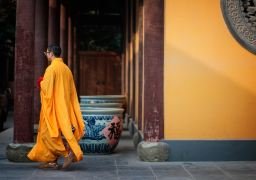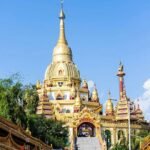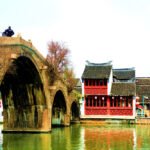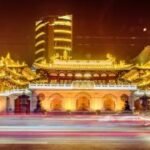Longhua Temple is a historic and grand ancient temple in the Shanghai area, with a history of over 1700 years. The temple’s name originates from the Buddhist story of achieving enlightenment under the Longhua tree. The temple’s central axis is lined with structures from south to north: the Maitreya Hall, the Mahavira Hall, the Hall of the Three Saints, the Abbot’s Chamber within an enclosed courtyard, and the Sutra Pavilion, totaling six halls. The Mahavira Hall is solemn and majestic, with three golden statues of Manjushri and Samantabhadra on the front, and an exquisite statue of the Goddess of Mercy on the island on the back. The walls on both sides of the hall are engraved with the Twenty Heavenly Kings and the Sixteen Arhats. The temple has bell and drum towers on its east and west sides. There is an additional charge to ring the bell in the bell tower, and a large drum with a diameter of 1.7 meters is housed in the drum tower. The eastern and western side halls include the Hall of Guanyin and the Arhat Hall. To the east of the Hall of the Three Saints are the Ranxiang Pavilion and the Peony Garden. Visitors to Longhua Temple can pay to enjoy vegetarian meals, which are so delicious that almost all visitors who come to burn incense will buy a bowl of vegetarian noodles, often resulting in long queues. During the New Year, the temple hosts bell-ringing events to welcome the year, with many citizens eager to ring the bell and offer incense to pray for a year of peace. In March and April, the Longhua Temple Fair takes place, and there is an old saying in Shanghai: ‘On the third day of the third month, go to Longhua to see the peach blossoms,’ as it is believed that this day is when Maitreya, in the form of the Bag Monk, appears. Next to Longhua Temple stands the Longhua Pagoda, which is said to have been built by Sun Quan of the Eastern Wu during the Three Kingdoms period to honor his mother. It was destroyed by war at the end of the Tang Dynasty and was rebuilt in the second year of the Taiping Xingguo period of the Northern Song Dynasty. Due to the soft soil in Shanghai, the Longhua Pagoda has tilted, and for preservation, visitors can only view the pagoda from the outside and are not allowed to climb it. The temple is open year-round from 07:00 to 16:30.








